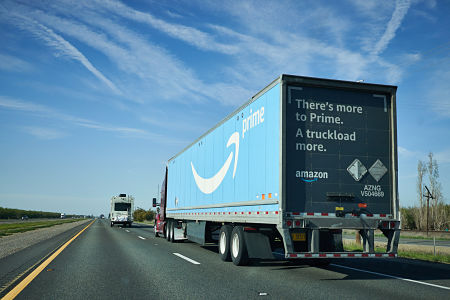Are Amazon-branded tractors a sign of the future?
Truck drivers have spotted Amazon-branded truck tractors in Pennsylvania, Texas, Ohio and California in recent weeks, as the mega-corporation continues its foray into the logistics market.
The tractors are what are known as “day cabs,” rather than “sleeper cabs,” indicating they are designed for distances of 400 miles or less, Satish Jindel of SJ Consulting Group recently told Business Insider.
Sindel said this likely means the tractors will move “middle mile” shipments – to and from fulfillment centers and delivery centers.
For the last mile, Amazon is using a fleet of Mercedes-Benz Sprinter vans, 2,000 Spartan vans and 100,000 Rivian vans that will join the fleet over the next several years.
The expansion of its trucking fleet is part of an overall foray into logistics that has seen the retail giant add cargo jets, 10,000 truck trailers, a network of ocean freighters and thousands of last-mile delivery vans.
“They’ve already got branded airplanes. They’ve got a last-mile delivery network that’s growing; they’ve got branded trailers — one of the only things left is tractors,” said Cathy Morrow Roberson, the founder of the consulting firm Logistics Trends & Insights. “This is just another piece of the puzzle.”
“It is another indication that Amazon is going to, in time, have a complete capability to handle all the transposition and distribution needs of its business and of its customers,” Jindel said. “They know having logistics is a core competency to their retail business.”
Disintermediation
A former Amazon executive, quoted in a Freightwaves.com article, said Amazon’s overall aim is to cut out the middle man in the logistics supply chain.
“This innovation and growth then manifests as continuously evolving towards the ability to sell everything and anything that is or can be sold. That’s the true Amazon flywheel: disintermediate to survive; monetize to fund innovation; innovate to grow; disintermediate to survive…”
The term “disintermediate” means “reduction in the use of intermediaries between producers and consumers.” What Amazon is doing is cutting out its shipping intermediaries.
Amazon is in the midst of a shift to one-day shipping, which is resulting in short-term losses.
The company appears to be taking control of its transportation costs by transitioning to in-house delivery and logistics. That means moving to in-house resources instead of relying on third parties such as UPS, FedEx of the U.S. Postal Service.
“We have great third-party partners as well in the transportation space,” said Brian Olsavsky, Amazon’s chief financial officer. “What we like about our ability to participate in transportation is that a lot of times we can do it at the same costs or better, and we like the cost profile of it too.”
The Amazon process
Amazon trailer trucks
Amazon trailer trucks, carrying more than 2,000 boxes at a time, bring orders from fulfillment centers to sortation centers, where packages are distributed by location and the required delivery speed. From here, they could be loaded onto a variety of transportation modes, from Amazon trucks and planes to carriers such as UPS, FedEx, and the U.S. Postal Service.
Airborne: Amazon Air planes
Charged with meeting Amazon’s two-day delivery window for Prime members, Amazon Air planes take flight from over 20 airports around the country. Packages on these aircraft are placed onto metal containers called Unit Load Devices, which can hold hundreds of boxes apiece in artfully slotted stacks. Each plane has the capacity to carry 30 or more containers.
Ground force: Amazon delivery service partners
The volume of orders is so vast that Amazon is recruiting Delivery Service Partners to help get orders where they need to go. The partners hire and develop their own teams of drivers, operating with anywhere from 20 to 40 vans and 40 to 100 employees, while Amazon provides training, a comprehensive toolkit, and ongoing support. Amazon also uses independent contractors through Amazon Flex.
Last-mile delivery expansion
Several weeks ago, Amazon announced the expansion of Counter, a network of staffed pickup points that gives customers the option to pick up their Amazon packages in-store at a partner location.
With this expansion, customers now have access to thousands more Amazon Hub Counter locations with Amazon’s new store partners GNC, Health Mart and Stage Stores. Delivery to a Counter location is available for the tens of millions of items sold on Amazon.com, and works with Same-Day, One-Day, Two-Day and Standard Shipping. The service is available to all Amazon customers at no extra cost.
“The response we’ve heard from our customers and partners after the launch of Counter earlier this year has been tremendous,” explains Patrick Supanc, worldwide director of Amazon Hub. “This new network of pickup points gives customers a pickup experience that is fast, flexible and convenient, and partners are thrilled with the strong engagement and additional foot traffic Counter is driving for their stores.”






